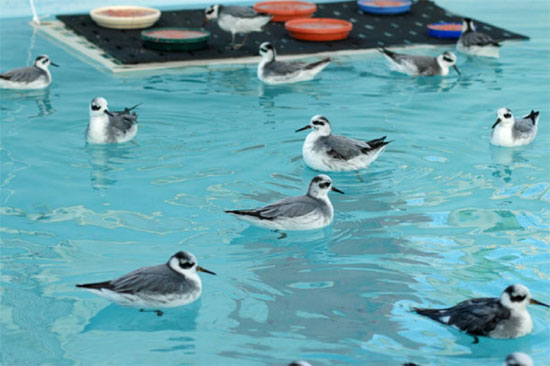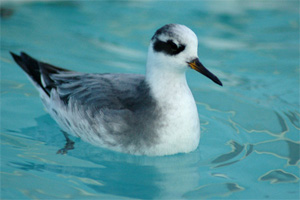- Red phalaropes are typically found at sea and are rarely seen on shore.
- From November 2005 through early January 2006 thousands of red phalaropes were blown onto central California beaches by heavy storms.
- Most of the birds brought to rehabilitation centers were found to be cold and starving.
Heavy storms from late November 2005 through early January 2006 blew thousands of red phalaropes (Phalaropus fulicaria) to Monterey and San Mateo county beaches. Volunteers from Beach COMBERS, a long-term monitoring program that keeps track of beached marine mammals and seabirds on the beaches of the Monterey Bay National Marine Sanctuary, recorded a higher number of red phalaropes than usual during their January survey. These small birds are typically found out at sea and are rarely observed from shore.
Necropsies conducted at the California Department of Fish and Game Marine Wildlife Veterinary Care and Research Center in Santa Cruz revealed evidence of malnutrition, including empty stomachs and muscle atrophy. Interestingly, small bits of plastic were also recorded in their stomachs. These birds feed at the surface of the water, picking up krill and plankton with their long slender bills, after stirring up the surface waters with their feet. Because of their feeding method, they also accidentally ingest floating plastics.
Many of the birds were brought live to rehabilitation facilities such as the Monterey Bay Aquarium, the Monterey Society for the Prevention of Cruelty to Animals (SPCA) and the International Bird Rescue Research Center (IBRRC) in Cordelia, California. Most of the birds were found to be cold and starving. Although some birds died in captivity, most have been released after receiving a warm bath, and being fed a diet of krill and worms.

Download the entire necropsy summary report: Click here (1 MB PDF)
Find more pictures of red phalaropes at the IBRRC website:
http://majicdesign.com/ibrrc/january/index.htm
Read the San Francisco Chronicle about this red phalarope event:
PDF download (88 KB)
Find more information on the red phalarope:
http://www.mbayaq.org/efc/living_species/default.asp?hOri=0&hab=3&inhab=462
